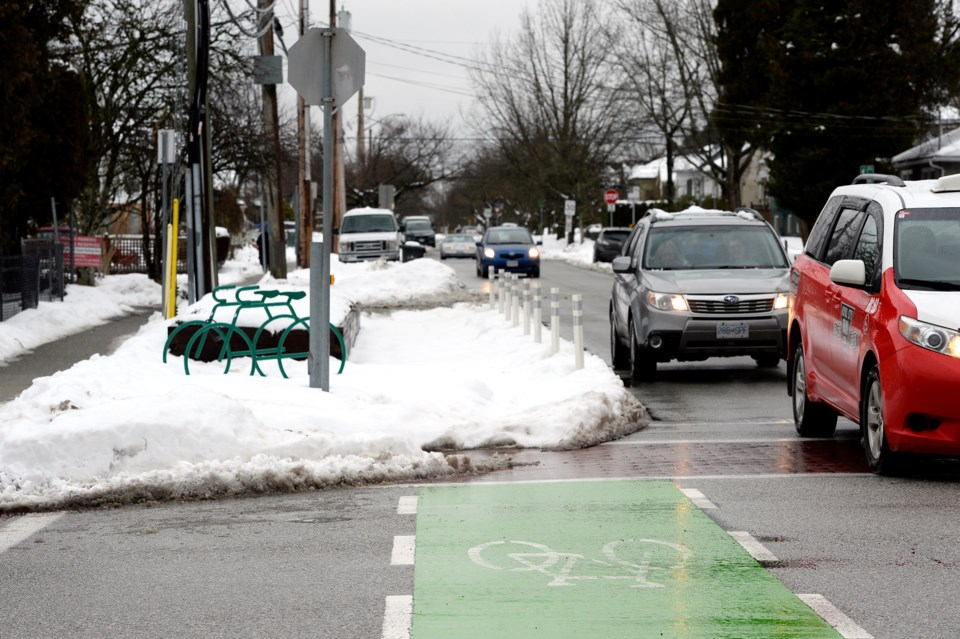HUB Cycling has no shortage of ideas on how to get more people walking and cycling – starting with safer cycling routes to the new high school.
Having taken part in the City of New Westminster’s engagement process regarding its proposed 2020 to 2024 capital budget and its seven bold steps to tackle climate change, some members of the local cycling advocacy group have thoughts on where the city should be focusing its energies.
Downtown resident Patrick Parkes firmly believes this year’s budget should include funds to build separated bicycle lanes on Sixth Street so students can cycle to the new high school safely separated from car traffic.
“I ask city council to do the right thing and ensure that students from all parts of the city will be able to take the responsible choice of cycling to school in safety. This may not be an easy thing for you to do. You are probably going to have to have parking removed from parts of Sixth Street in order to make this happen, but after all, streets are not storage spaces for private property,” he recently told city council. “If you are serious about being bold in response to the climate crisis, sometimes you will actually have to be bold and I urge you to do so.”
In 2019, representatives of HUB Cycling appeared before council on several occasions to press for safer and more comfortable cycling access to the new high school by opening day in September 2020. A staff report said an expedited design and engagement process for these connections isn’t contemplated before opening day because of timing related to ongoing school site planning and other priorities that staff are focused on, including the Agnes Greenway and improvements to the Rotary Crosstown Greenway.
According to a staff report, the Sixth Street route would require significant stakeholder engagement, technical analysis and design, and discussion with TransLink to ensure the 106 bus service isn’t compromised.
The city’s 2020 to 2024 proposes a number of projects related to sustainable transportation, including:
· Walking and cycling connections through Moody Park to New Westminster Secondary School, plus other greenway network spot improvements: $1,762,100.
· Rotary Crosstown Greenway – planning, analysis, design and construction of protected bike lanes between Fifth and Eighth streets: $5 million.
· Agnes Greenway – protected bike lanes from Pattullo Bridge to Carnarvon/Lorne streets: $5,394,400.
· Brunette Fraser Greenway multi-use path and rail crossing on Braid Street between Brunette Avenue and Vulcan: $3.5 million.
· Central Valley Greenway improvements at Columbia and DeBeck/Cumberland and Brunette: $1,164,000.
For the next five years, longtime resident Brad Barber said the city should prioritize a complete connected bicycle network so citizens can safely get to school, appointments and shopping, while also reducing pollution. For 2020, he’d like council to direct staff to focus on safer routes to the new high school and on routes from downtown to uptown.
Barber said New Westminster has “no signs and no routes” to get safely from downtown to uptown, which affects cyclists, pedestrians and people using mobility scooters and other forms of personal transportation. He said four high-cost segments of cycling routes are the priorities in the city’s budget but tackling those projects will leave no money or staff time to do other improvements – smaller projects that will actually cost less and have a greater impact on safety.
“Before you decide to spend $13 million on expensive three-block sections of cycling routes, which we would all love, please consider your own master transportation plan,” he said. “For the last five years your plan has sat on city shelves.”
Barber said the master transportation plan promised a completely connected bicycle network, but there still isn’t a single bike route to provide a safer pathway from areas such as Douglas College and Qayqayt Elementary School to the uptown.
Sapperton resident Heidi Braacx said the city should support the hierarchy included in the city’s master transportation plan, which emphasizes walking, cycling and public transit, followed by commercial vehicles and cars.
“Walking and cycling in New Westminster is often noisy, smelly, frustrating and, quite honestly, frightening,” she said.
Braacx said “an overwhelming majority” of cyclists are men.
“Contrast this with cyclists in cities where transportation hierarchy is taken very seriously. In Copenhagen, where 62% of the population chooses cycling to get to work or school, 53% of cyclists are women, who frequently ride in regular street clothes and not often think it necessary to wear a helmet,” she said. “These people do not make these choices because they are activists or risk-takers; they are doing it because it’s more convenient to bike than take the car and they feel completely safe.”
Robert Wong said he’d like the city to increase the budget to provide for more mobility lanes, which could be used by low-speed vehicles such as bikes, scooters and ebikes, which are the “trend of the future” and are the “perfect option” for the hills of New Westminster.



